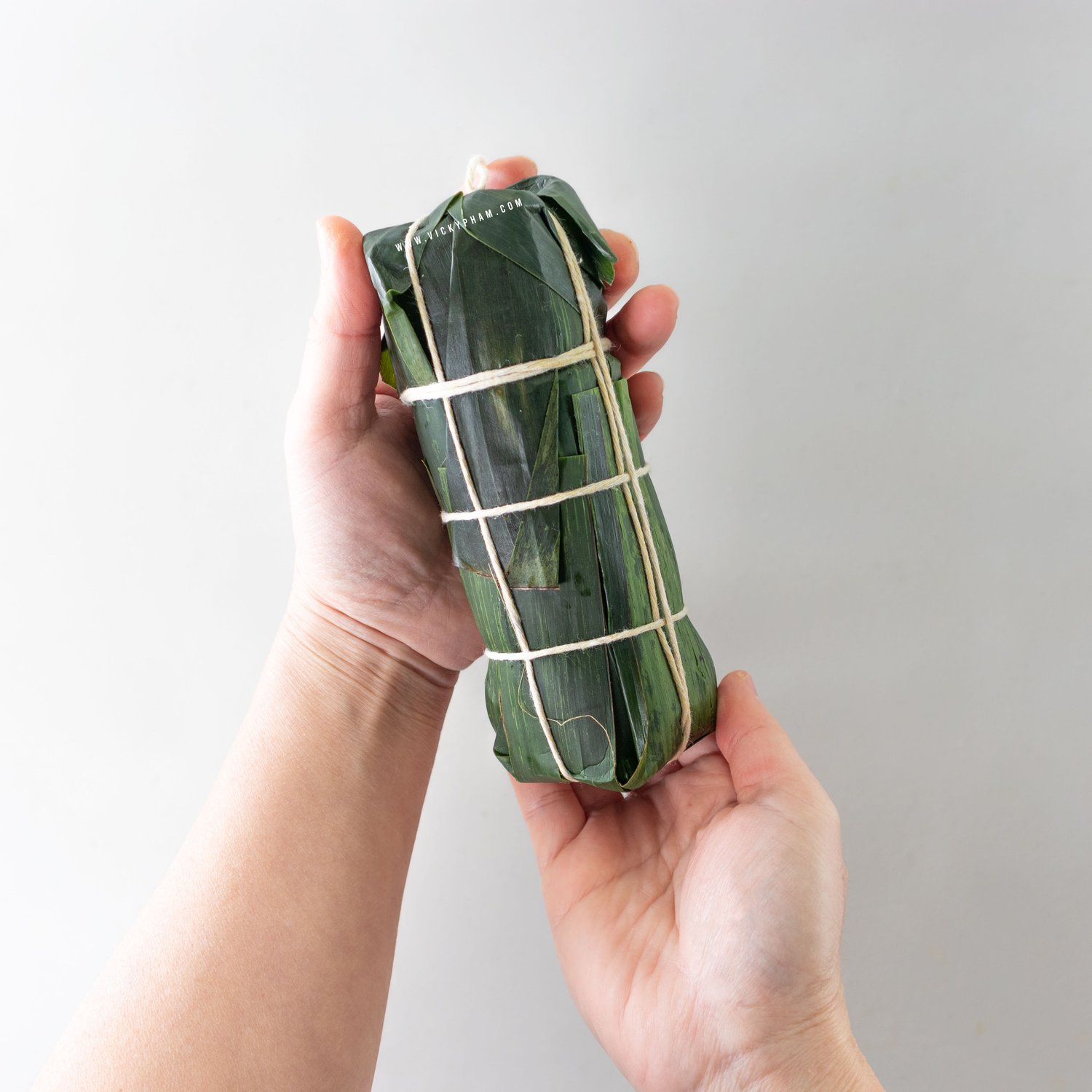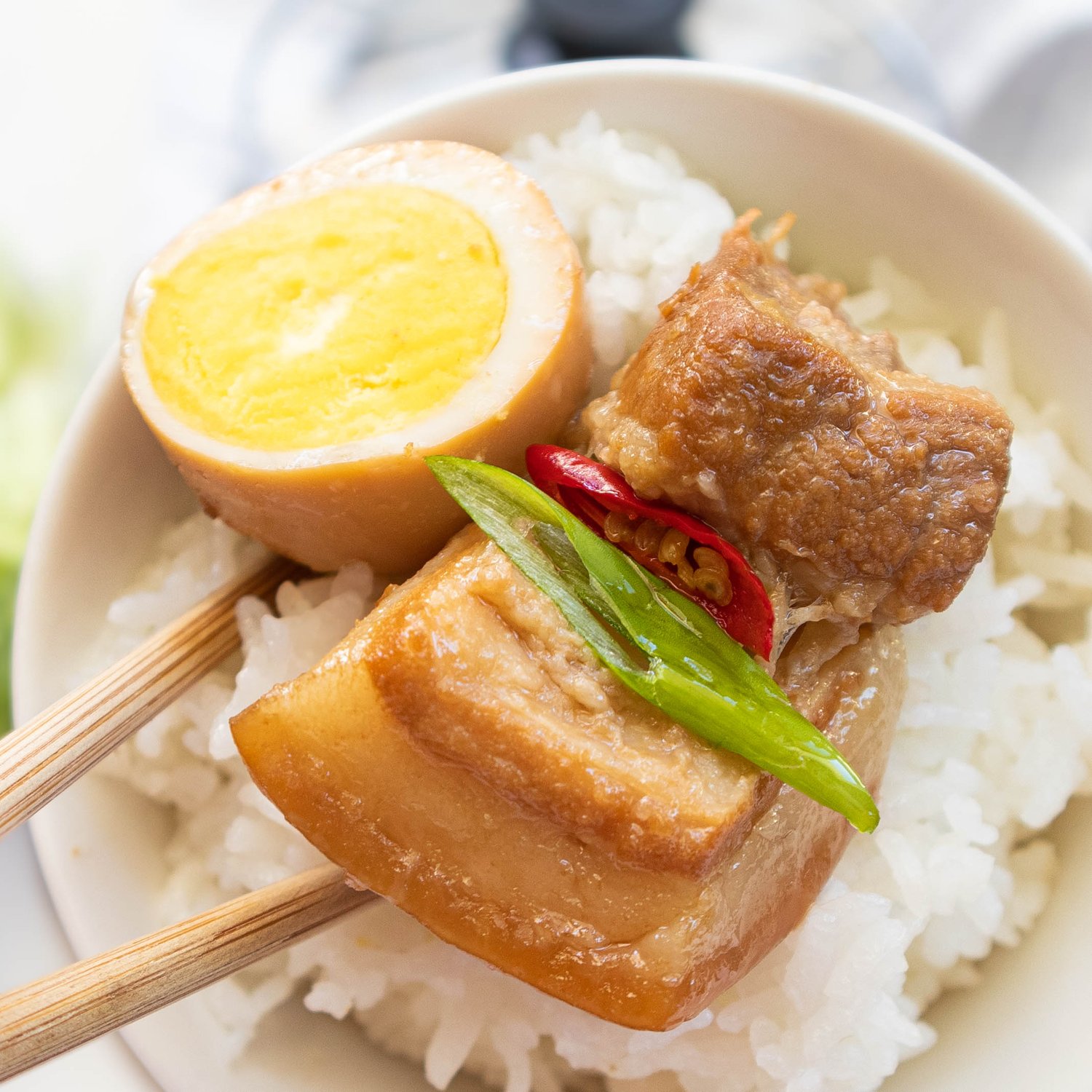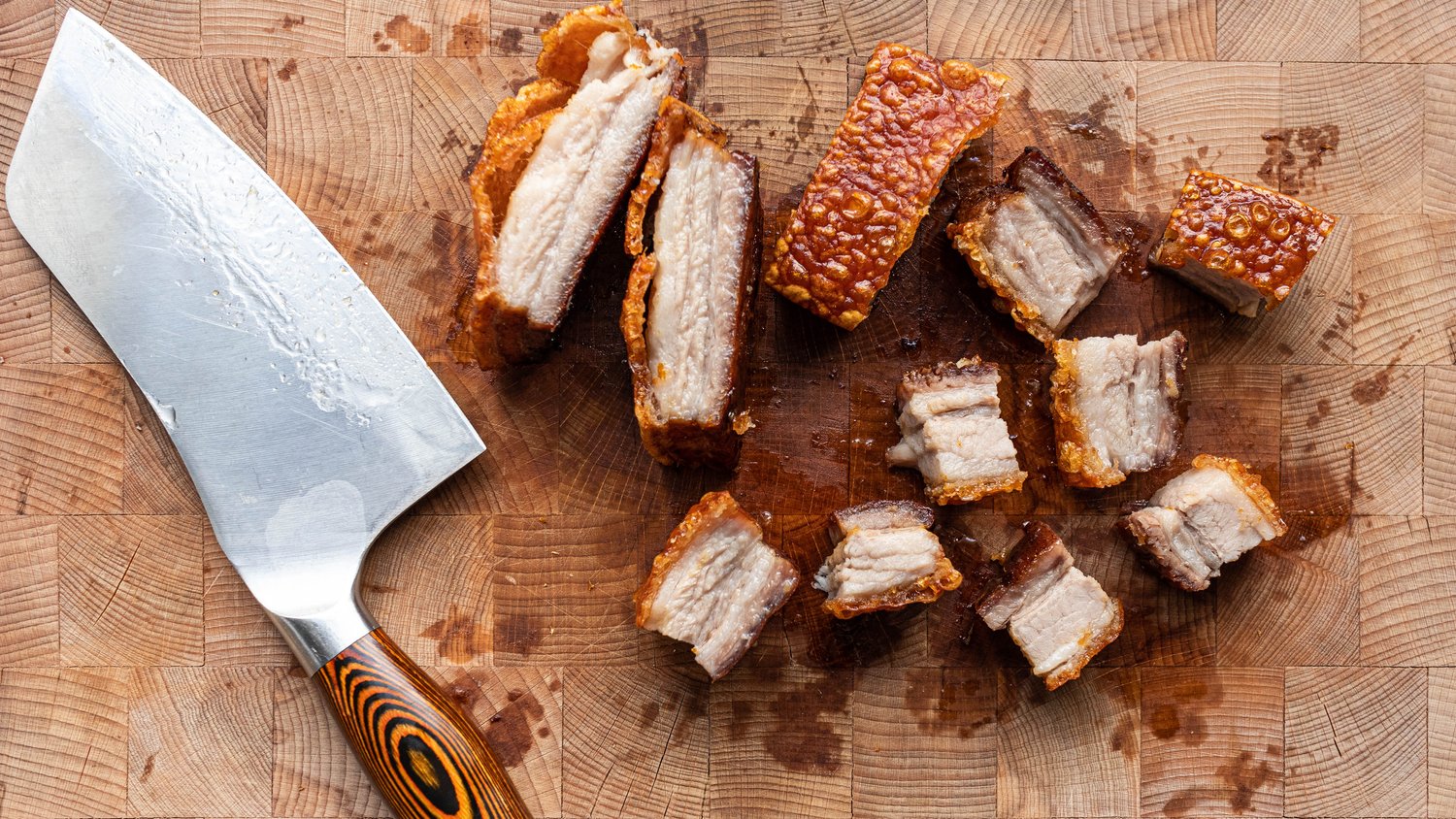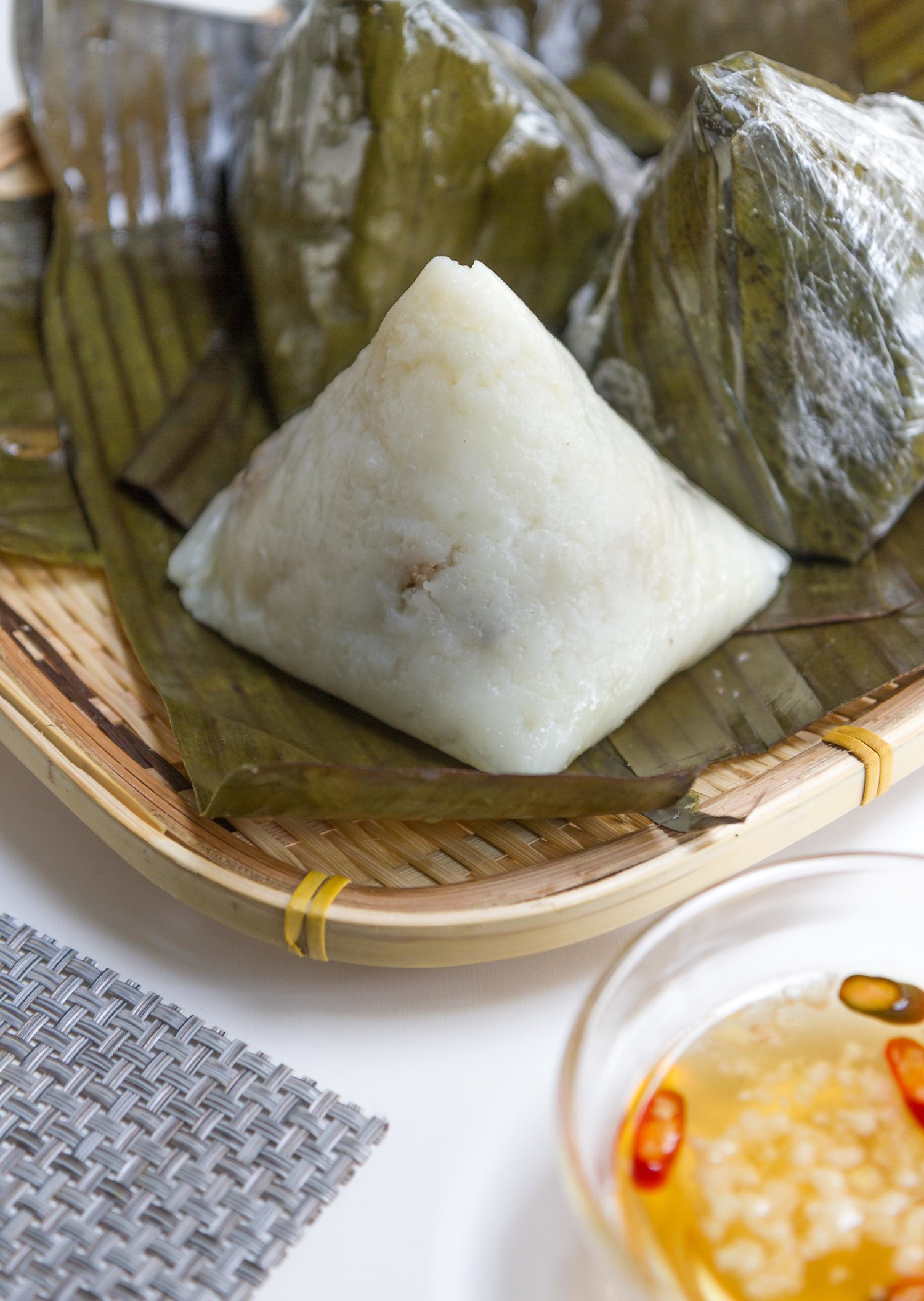Vietnamese Savory Square Cake for Lunar New Year (Bánh Chưng)
This post contains affiliate links which we are compensated for if a purchase is made. Using links costs you nothing and helps to support the ongoing creation of content. • Jump to Recipe
As the Lunar New Year approaches, Vietnamese households bustle with preparations.
Among these activities is making Bánh Chưng, a traditional savory rice cake that is a staple of Tết celebrations.
This recipe includes instructions for both stovetop and pressure cooker. I also provide a detailed guide to the wrapping process, complete with step-by-step photos.
I hope these comprehensive instructions will make Bánh Chưng less daunting so that you can make this wonderful dish successfully at home.
What is Bánh Chưng?
Bánh Chưng is a square rice cake filled with sticky rice, pork belly, and mung beans, all wrapped in banana leaves and tied tightly with strings.
It’s the square variant of its identical counterparts Bánh Tét, which is shaped into a log, and Bánh Ú, which is shaped into a cone.
All three rice cakes are quintessential foods for Vietnamese Lunar New Year.
Bánh Chưng, including its variants, is traditionally boiled for hours over a wood fire, with family members coming together to stoke the fire and celebrate the holiday.
Vietnamese Lunar New Year (Tết)
Tết, short for Tết Nguyên Đán, is the most important Vietnamese holiday, celebrated by Vietnamese people all over the world. It typically falls in late January or early February, marking the arrival of spring and new beginnings.
This holiday is celebrated by a week of feasting, drinking, and quality time with family and friends. During this period, manual labor, such as cleaning and cooking, is avoided. It’s believed that one's activities during Tết set the tone for the new year.
What You Will Need
Lets get cooking. To make Bánh Chưng, gather the following ingredients and kitchen items:
Pork Belly: Pork belly is readily available at Asian supermarkets.
Pork belly slabs are usually located at the meat counter towards the back of the store. Ask the nice people behind the counter to select you a piece that is even and thin, about 1-inch in thickness if possible. You also want one with thin layers of fat as pork belly can be extremely fatty.
One slab of pork belly at the Asian supermarket is typically 1-½ lbs which is perfect for this recipe.
If getting the attention of the person behind the counter is too difficult (it happens sometimes), you can pick up pork belly yourself in the refrigerator aisle. These are usually already cut into strips.
The traditional pork belly for Bánh Chưng includes the skin, but the choice is yours. Skinless pork belly is a leaner option.
If pork belly is unavailable, substitute with pork shoulder.
Glutinous Rice: Glutinous rice is also known as sweet rice. Make sure that the package says sweet rice or glutinous rice to ensure you are getting the right kind.
Mung Beans: Look for dried split mung beans. They are located in the dry good aisle in clear baggies.
Seasonings: To season the pork belly, we will be using shallots, salt, sugar, fish sauce, ground black pepper, and bouillon powder.
I’m using chicken bouillon powder but you can also use mushroom bouillon powder.
Don’t like bouillon powder? No problem. You can replace the amount with a halved amount of MSG.
If bouillon powders and MSG aren’t your thing, simply omit.
Banana Leaves: Banana leaves imparts a mild green tea aroma and light green tint on the rice cake during cooking.
You can typically find fresh banana leaves at Asian supermarkets. Look for them in the produce section. If fresh leaves are unavailable, some stores also offer frozen banana leaves. I’m using frozen banana leaves for this recipe which requires less prep.
Large stock pot with a lid or pressure cooker: To cook the rice cakes, you can either use an 8-quart stock pot with a lid or an 8-quart pressure cooker.
Stove top cooking will take about 6 hours. Pressure cooker will take about 2.5 hours total (1.5 hours cooking and 1 hour to depressurize).
Strings: When tying the cakes, you can use cotton cooking twine or those colorful plastic/nylon food-safe strings commonly found in the houseware section of Asian supermarkets.
Mold for the rice cake: Utilizing a mold greatly helps to get a square or rectangle shape. I'm using my tofu press mold, which measures 5-¾” x 4-¾” x 2”. You can use any square or squarish mold you have. The specific dimensions aren't crucial, but make sure it’s about 2 inches in height. If necessary, you can also create a mold out of cardboard if you don't have one already.
How to Make It
Step 1: Overnight Preparations
Soak rice and beans
The dried rice and beans require overnight soaking (at least 8 hours). This ensures they will absorb enough water to cook properly.
Begin by rinsing the dried glutinous rice grains in a colander until water runs clear. Transfer to a mixing bowl and cover with plenty of water. Do the same for the dried mung beans.
Drain the rice and mung beans into separate bowls and season with salt.
Marinate pork
To remove surface impurities and any unwanted odor, generously rub pork belly with coarse salt. Rinse thoroughly under running water to remove the salt and pat the pork belly dry with paper towels.
Cut into thin slices or 4 slabs that will fit the center of the mold.
Season pork belly with salt, sugar, fish sauce, ground black pepper, shallots, and bouillon powder.
Step 2: Prep banana leaves (next day)
Thaw the banana leaves if frozen. We will be using 4 sheets of banana leaves per cake, one for each corner. This recipe makes 4 cakes so we will need 16 sheets. Keep extras in case of tearing.
The width of the banana leaf is the width of the short side of the mold, plus one of its sides (2 inches). See picture below.
Cut with scissors to ensure a sharp 90° angle on all corners.
Once cut to size, rinse sheets with hot water to clean. Wipe with paper or kitchen towels to dry and remove any white residue. The white residue is calcium deposits, typically found on frozen banana leaves.
Step 3: Fold banana leaves (origami time!)
When folding, it really doesn’t matter whether you put the glossy side up or down. I find that after it’s boiled, it all looks pretty much the same.
If presentation is important to you, particularly before boiling, place the banana leaf with glossy side down.
For each banana leaf, fold them like the diagram below.
Pull the bottom right corner to the left edge (1). Pull the bottom point (2) up to align with the left edge. Make a seam along the fold (3).
Pull the top right corner to the left (4) to align with the diagonal and make a seam along the fold (5). Open up the flap again (6).
Hold (7) and pull down. Flip upright by 90° so you have a square base (8). Transfer the folded leaf to a corner of the mold (9).
Repeat this origami fun three more times until you get all four edges of the mold covered.
Step 4: Filling
Divide the rice, beans, and pork belly into four since we are making four cakes.
Start with a thin base of rice, making sure to go all the way to the four corners (1). Then add a thin layer of mung beans in the center (2). The mung bean layer does not go all the way to the edge. Add pork on top of the mung beans (3).
Cover pork with mung beans (4) then rice (5), making sure the rice completely goes all the way to the edge and down the sides. Fold the banana leaves down like you would a present (6).
Step 5: Tying
Don’t let the pictures fool you. It’s really not that complicated when you are actually doing it.
Cut four pieces of string, each one 90 inches in length.
Top of Bánh Chưng
Put the center of the string across the folds to hold them down (1). Flip the mold upside down (2).
Bottom of Bánh Chưng
Remove the mold (3). Make a loose knot at the center (4). Turn the knot 90° (5).
Top of Bánh Chưng
Turn the cake upside again. You naturally want to make a loose knot in the middle (6) right? But shift this knot to the left side and turn 90° (7).
Carefully flip the cake again. Repeat the process until you get to (8).
If all fails, just wrap it as best you can with strings and cover the whole thing with foil or saran wrap.
The professionals don’t even bother with a mold. They simply wrap Bánh Chưng like in the below picture and shape it into a square or rectangle while folding. I tried this and failed.
Step 6: Cooking
Stove-top cooking: Boil the rice cakes in a large 8-quart stockpot on the stovetop on a medium-low simmer, covered. Make sure they are always submerged in water to ensure even cooking. Use a large ceramic bowl or plate to weigh the cakes down if needed. Stove-top cooking will take about 6 hours. Check the water level occasionally and add water as needed.
Pressure cooker: Add the rice cakes into the inner pot of an 8-quart pressure cooker. Add water to the maximum fill line and pressure cook on high for one hour and 30 minutes.
Once done, allow the pressure cooker to depressurize on its own (about one hour) before opening the lid.
Step 7: Cooling
Once cooked, remove the rice cakes and drain dry. Press it under some weights such as a cutting board and a bag of flour on top. This helps to remove excess water and make the top and bottom completely flat.
Allow the rice cakes to cool to room temperature before slicing. Remove all the banana leaves and slice them into quarters with an oiled knife or a thin string.
How to Serve Bánh Chưng
Bánh Chưng can be enjoyed, as is, at room temperature. You can also pan-fry the pieces in a bit of oil for a golden crunchy crust and enjoy it warm.
Serve it with Vietnamese Pickled Vegetables (Dưa Món) for the ultimate taste of Vietnamese Lunar New Year.
Storage
Wrap the cooked Bánh Chưng in plastic wrap or foil then transfer them to the fridge or freezer. It lasts in the fridge for up to one week or in the freezer for up to 8 months.
FAQs
Do I eat the banana leaves?
Do not eat the banana leaf.
You May Also Enjoy These Other Tết Recipes
Bánh Chưng‘s Cylindrical cousin (Banh Tet)
Red Sticky Rice
Pickled Dried Vegetables in Fish Sauce
Candied Coconut Ribbons
Braised Pork Belly & Eggs with Coca Cola
Pickled Bean Sprouts with Garlic Chives
Steamed Chicken with Turmeric and Coriander
Ground Pork Stuffed Bitter Melon Soup
Crispy Egg Rolls
Caramelized and Braised Pork Belly with Eggs
Spicy Beef Jerky (No Food Dehydrator Needed)

Vietnamese Savory Square Cake for Lunar New Year (Bánh Chưng)
Ingredients
Instructions
- Soak rice and beans: Rinse the dried glutinous rice grains in a colander until water runs clear. Transfer to a mixing bowl and cover with water. Do the same for the dried mung beans. Drain the rice and mung beans into separate bowls and season with salt.
- Marinate pork: To remove surface impurities and any unwanted odor, generously rub the pork belly with coarse salt. Rinse thoroughly under running water to remove the salt and pat the pork belly dry with paper towels. Cut into thin slices or 4 slabs that will fit the center of the mold. Season pork belly with salt, sugar, fish sauce, ground black pepper, shallots, and bouillon powder.
- Prep banana leaves (next day): Thaw the banana leaves if frozen. We will be using 4 sheets of banana leaves per cake, one for each corner. This recipe makes 4 cakes so we will need 16 sheets. Keep extras in case of tearing. The width of the banana leaf is the width of the short side of the mold, plus one of its sides (2 inches). See picture in blog for reference. Cut with scissors to ensure a sharp 90° angle on all corners. Rinse sheets with hot water to clean. Wipe with paper or kitchen towels to dry and remove any white residue.
- Fold banana leaves: For each leaf, refer to folding pictures in the blog to get the edge for the mold.
- Filling: Divide the rice, beans, and pork belly into four. For each cake, start with a thin base of rice, making sure to go all the way to the four corners. Then add a thin layer of mung beans in the center. Do not go all the way to the edge. Add pork on top of the mung beans. Cover pork with mung beans then cover everything with rice, making sure the rice completely goes all the way to the edge. Fold the banana leaves down like you would a present.
- Tying: Put the center of the string across the folds to hold them down. Flip the mold upside down. Remove the mold. Make a loose knot at the center. Turn the knot 90° to change direction and quickly flip the cake. Continue making loose knots and turning the knot 90° until the cake is evenly wrapped with three vertical strings and three horizontal strings. If wrapping fails, just wrap it as best you can with strings and cover the whole thing with foil or saran wrap. See pictures in blog for reference.
- Stove-top cooking (Option 1): Boil the rice cakes in a large 8-quart stockpot on the stovetop on a medium-low simmer, covered. Make sure they are always submerged in water to ensure even cooking. Use a large ceramic bowl or plate to weigh the cakes down if needed. Stove-top cooking will take about 6 hours. Check the water level occasionally and add water as needed.
- Pressure cooker (Option 2): Add the cakes into the inner pot of an 8-quart pressure cooker. Add water to the maximum fill line and pressure cook on high for one hour and 30 minutes. Once done, allow the pressure cooker to depressurize on its own (about one hour).
- Once cooked, remove the rice cakes and drain dry. Press it under some weights such as a cutting board and a bag of flour on top. This helps to remove excess water and make the top and bottom completely flat. Allow the rice cakes to cool to room temperature. Remove all the strings and banana leaves. Slice into quarters with an oiled knife or thin string before serving.
- Serving: Bánh Chưng can be enjoyed, as is, at room temperature. You can also pan-fry the pieces in a bit of oil for a golden crunchy crust and enjoy it warm.
Nutrition Facts
Calories
523Fat
23 gSat. Fat
8 gCarbs
62 gFiber
3 gNet carbs
59 gSugar
1 gProtein
15 gSodium
635 mgCholesterol
31 mgThe values provided should be considered estimates. Factors such as brands purchased, natural variations in fresh ingredients, etc. will change the nutritional information in any recipe. To obtain accurate nutritional information for a recipe, use your preferred nutrition calculator to determine nutritional information with the actual ingredients and quantities used.



















